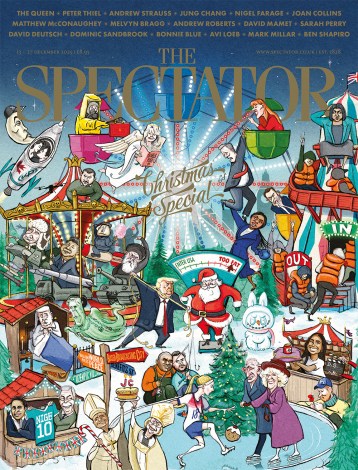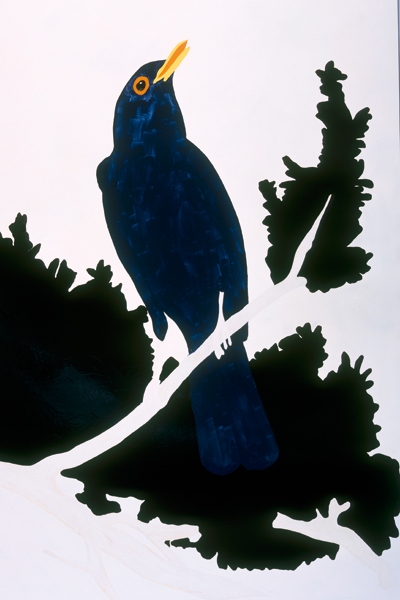In the wake of the Roy Lichtenstein blockbuster at Tate Modern comes Patrick Caulfield at Tate Britain, and what a contrast! Where Lichtenstein looks increasingly like a one-trick pony, an assessment driven home by the excessively large show, Caulfield emerges as fresh, witty and visually inventive. Undoubtedly this impression is fostered by the size of the exhibition: Tate Britain’s Linbury Galleries have been divided between Caulfield and Gary Hume, allowing each enough space for a highly focused solo exhibition. There are thus only 35 paintings by Caulfield spanning his entire career, and one leaves his show wanting to see more, not suffering from the usual museum overkill. This is an excellently selected and installed exhibition: a much-deserved tribute to one of the neglected greats of 20th-century art.
A victim of the art historian’s lust to categorise and pigeonhole, Patrick Caulfield (1936–2005) is all too frequently lumped with the Pop artists who came to prominence in the mid-1960s. Caulfield always preferred the designation of ‘formal artist’, and looking at his highly intelligent interpretations of landscape, interior and still-life, this description makes absolute sense. He was a master of pictorial logic and paradox, a painter of contemporary life, drawn to the kitsch and everyday, which he formalised and contained in images of classic restraint and romantic lushness. As the critic Christopher Finch observed, Caulfield was a ‘romantic disarmed by his own sense of irony’.
Unlike the Pop artists, he was little interested in American art (with the exception of Edward Hopper and Stuart Davis), and his lodestar was French modernism. He looked to the decorative brilliance of Matisse and Dufy, and the stylisation of Léger, Braque and Gris. To begin with, he deliberately espoused the exotic and decorative, rather than the traditional landscape and nude of English art, avoiding the brushstroke in his paintings, using a sign-painter’s technique to achieve those distinctively flat glossy surfaces. He liked painting stereotypes and generic imagery, focusing on imaginary but plausible places of particular types. He painted moments of frozen possibility: interiors where something might be about to happen. Howard Hodgkin has remarked that Caulfield was ‘a connoisseur of spaces where people gather for pleasure, such as restaurants and bars, and he managed to convey in his paintings the melancholy that can haunt such spaces — born of emptiness and artifice’.
The Tate’s show starts with ‘Concrete Villa’, a black-and-white painting from 1963, before moving swiftly on to the richness of ‘Santa Margherita Ligure’, hung next to the popular Tate-owned ‘Pottery’. This bright assemblage of pots, like a fusty archaeological trove gone psychedelic, is actually quite subversive, playing with space and perspective by flattening half the pots into outline and depicting the nearer ones as if seen almost in the round from above. And the uniformity of handling is curiously broken by the scrubby paint on a couple of purple pots and on the blue-green-grey ones. But perhaps the most exciting painting here is ‘Bend in the Road’ (1967), a less familiar beauty of marked impact and resonance.
The impressive first section gives way to a more architectural group of paintings from the 1970s, including the sumptuously abstract ‘Window at Night’ and the very big and intricate ‘Entrance’, its complex structure badged all over with meticulously naturalistic flowers. Caulfield now sought out the convoluted and claustrophobic, inventing mad patterns and different ways of representing them, from the open and linear to the densely hyper-realist. He constantly risks overloading a painting, but remarkably his tensile structures never topple. ‘Town and Country’ is hilarious: the stridency of conflicting patterns approaches the cacophonic, yet somehow this enormously sophisticated artist resolves all problems. In such company, a smaller painting such as ‘Still Life: Mother’s Day’ (1975) is positively spare in construction though equally potent. The exhibition ends with a series of powerful and uncompromising preludial visions, including Caulfield’s very last painting, the poignant ‘Braque Curtain’.
Gary Hume (born 1962) has wittily painted the entrance doors to his exhibition to look like…doors. It’s an intriguing strategy which entices you to enter his show. Hume has always been good at doors, and paintings of doors were what I first remember of his work, at the Saatchi Gallery in the 1990s. The present show includes one portal painting: ‘Red Barn Door’ from 2008, enamel paint on aluminium, now in the Tate collection. Of the other pictures I much preferred the more textured cloisonné ones, such as ‘Tulips’ (2009) or ‘The Cradle’ (2011), in which rimmed areas of bright paint stand out against the flat and featureless grounds. Hume seems to have gone for a similar apotheosis of banality to Caulfield, but whereas the older artist invests his work with formal interest, Hume relies too heavily for my taste on blandness.
The large areas of uniform shiny paint and lax shapes leave me unmoved — perhaps this is the intention? — though a whisper of poetry stealing in with the pink edging to ‘Birdsong’ suggests otherwise. The one painting I really liked was ‘Nicola as an Orchid’, which has a lyrical eloquence to it. Revealingly, it is one of the most minimal paintings, with much of the surface left as blank aluminium. I found myself wishing I could like the work more than I do on this showing. Perhaps the selection is not truly representative? Certainly it doesn’t help to be exhibiting cheek-by-jowl with such a modern master as Caulfield. As a colleague remarked, Hirst gets Tate Modern, Sarah Lucas gets the Whitechapel (this autumn), and Hume is given half the Linbury Galleries. What does this say about how he is viewed by the powers that be?
The Waddington show of Caulfield is an excellent supplement to the Tate survey, not least because it includes set designs, working studies and more finished pencil drawings made for exhibition. These are fascinating and often very beautiful — particularly the series of lamp studies from 1991, which reminds us that one of Caulfield’s earliest works was a rare self-portrait with a lamp dangling above him, a highly accomplished pencil drawing from 1951. A group of 1960s paintings provides further evidence of his early abilities, and ‘Landscape with Birds’ (1963) is a welcome black-and-white work. ‘Corner of the Studio’ (1964) and ‘Rooftops’ (1965) are both splendidly spare images, but the unfamiliar ‘Earthenware’ (1966) is a superb example of the less-is-more philosophy. A group of smaller later paintings contrasts with five vast canvases from the 1980s and 90s, full of slicing shapes of light and shadow, trompe l’oeil and witty juxtapositions. There’s never been an artist quite like Caulfield: high time he was internationally celebrated.






Comments